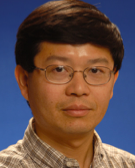Speaker
Professor
Rui
Q.
Yang
School
of
Electrical
and
Computer
Engineering
University
of
Oklahoma
Title
Quantum Engineered Optoelectronic Devices based on Interband Cascade Structures
Abstract
Interband cascade (IC) lasers, which are the first quantum engineered optoelectronics devices based on IC structures, take advantage of the broken band-gap alignment in type-II InAs/Ga(In) Sb quantum wells to reuse injected electrons for photon generation with high quantum efficiency [1]. Unlike intraband quantum cascade lasers, IC lasers use interband (conduction to valence bands) transitions for photon emission without involving fast phonon scattering, making it possible to significantly lower the threshold current density. Significant progress has been achieved in the development of high-performance IC lasers [2-3]. Some outstanding performance features such as low threshold current densities (e.g. <2 A/cm2 at 80 K, <200 A/cm2 at 300 K) and low power consumption (e.g. <0.1 W in cw operation at room temperature) partially verified the advantages of IC lasers. Also, efficient IC lasers have been demonstrated in the long wavelength IR region (>10 waveguides. Recently, other quantum engineered optoelectronic devices such as infrared photodetectors and photovoltaic cells [4-5] have been explored based on IC structures. The unique features and status of these optoelectronic devices based on IC structures will be reviewed and discussed with recent experimental results.
- R. Q. Yang, at 7th Inter. Conf. on Superlattices, Microstructures and Microdevices, Banff, Canada, August, 1994; Superlattices and Microstructures 17, 77 (1995); “Novel concepts and structures for infrared lasers”, chapter 2 in Long Wavelength Infrared Emitters Based on Quantum Wells and Superlattices, M. Helm, editor, Gordon and Breach, Singapore, 2000.
- I. Vurgaftman, W. W. Bewley, C. L. Canedy, C. S. Kim, M. Kim, C. D. Merritt, J. Abell, J. R. Lindle, and J. R. Meyer, “Rebalancing of internally generated carriers for mid-infrared interband cascade lasers with very low power consumption”, Nature Communications, 2, 585 (2011).
- R. Q. Yang, et al. “Recent progress in development of InAs-based Interband Cascade Lasers” Proc. SPIE, 8640, 86400Q (2013); and references therein.
- R. Q. Yang, Z. Tian, Z. Cai, J. F. Klem, M. B. Johnson, and H. C. Liu, “Interband cascade infrared photodetectors with superlattice absorbers”, J. Appl. Phys. 107, No. 5, 054514 (2010).
- H. Lotfi, R. T. Hinkey, L. Li, R. Q. Yang, J. F. Klem, M. B. Johnson, “Narrow-Bandgap photovoltaic devices operating at room temperature and above with high open-circuit voltage”, Appl. Phys. Lett, 102, 211103 (2013).
Speaker Biography

Invited by: Professor Dayan Ban and the Waterloo Institute for Nanotechnology